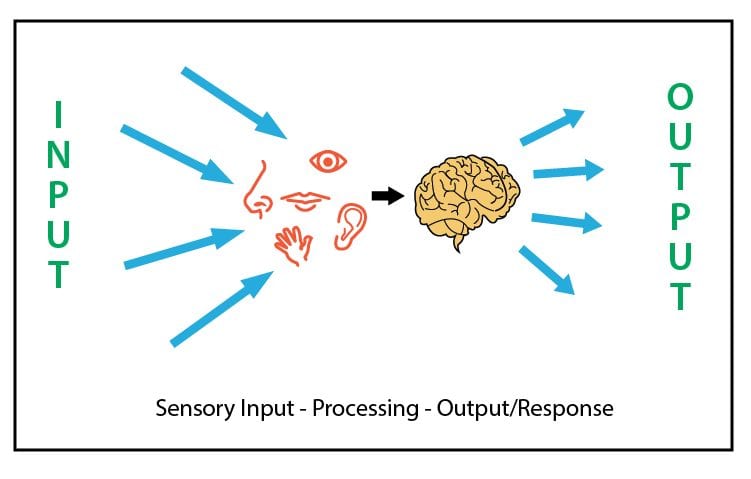The function of our sensory systems working together impact our daily actions and behaviors. When one system feels out of sorts, it becomes more difficult to feel regulated and safe. It is so important to nurture our sensory systems with the input and information they need to help with regulation and modulation of our mind and body.
Sensory processing is the way our nervous system receives, interprets, and responds to sensory input from our environment. Sensory processing impacts motor planning, body awareness, and tactile/auditory discrimination.
Sensory processing skills are foundational skills of development that are needed before learning can occur functionally and effectively!
Our Senses
There are 8 sensory systems that work together to provide a general perception of our body in relation to the environment:
- Auditory (Hearing)
- Tactile (Touch)
- Visual (Sight)
- Proprioceptive (Body Awareness)
- Vestibular (Movement)
- Olfactory (Smell)
- Oral Sensory/Gustatory (Taste)
- Interoception (Inner Body Sensations)

Auditory
The auditory (hearing) sense helps to bring awareness to noises and sound. It allows us to retrieve auditory information, organize it, and react appropriately. It is needed for listening, communicating, and socializing.
Differences in the ability to interpret sound input can impact a person’s response to specific sounds/noises and may result in being overstimulated, overwhelmed, or startled. When more sensitive to auditory input, one may hear things or be hypersensitive to sounds that aren’t usually noticed by others, such as the buzzing of a lightbulb. They may also be more distracted with sounds around them.
Tactile
The tactile (touch) sense helps to bring awareness to touch (light and deep), textures, changes in temperature, vibration, and pain through skin receptors. This sense provides feedback about the type of input that is being felt, and also allows a person to figure out what is being touched without needing their sight (a skill known as “stereognosis”).
Differences in the ability to interpret touch input can impact a person’s response to touch input that may be aversive (strong dislike), not enough (too light of pressure), or ability to tolerate certain textures and feelings.
Visual
The visual (sight) sense helps to see and notice objects and scenes that are processed, organized, and interpreted in order to navigate through different settings and locate objects/scenes that are wanted. The visual system has an influence on the development of visual perceptual skills.
Differences in the ability to process visual input may impact the way one acts or responds to visual input in the environment. For example, some might be looking for more visually stimulating input by looking more closely at objects, squinting to see them in a different way, or looking at quick moving/spinning things. On the other hand, some may show sensitivity to bright lights or excessive movement and items around them.
Proprioceptive
The proprioceptive (body awareness) sense, found in the sensory receptors of our joints and muscles helps to know where the body is positioned in space, and control/coordinate the direction and amount of force needed when moving. A simple example of the proprioceptive sense in play is the amount of pressure applied when handwriting – is it light, just right, or too hard? When there are differences in the ability to sense where the body is in space, it is more difficult to “feel” or know how much force is needed when completing a task.
Our joints and muscles receive input when the sense is stimulated through movement and pressure at the limbs such as pushing, pulling, lifting, hanging. Heavy work tasks, such as putting away heavy groceries, pushing a cart in the grocery store, pulling on a wagon, and lifting weighted balls are some examples of tasks that provide proprioceptive input. Other proprioceptive input activities are crawling, engaging in an obstacle course, doing the monkey bars, swimming, vacuuming, and yoga poses.
Some well known strategies that also provide proprioceptive input include the weighted blanket, wearing a weighted vest or compression vest/undergarment, and playing with resistive theraputty. Consult with an occupational therapist for specific recommendations.
*This sense is important because it allows one to feel more regulated, which improves attention, learning, playing, and completing tasks.*
Vestibular
The vestibular (movement) sense helps to recognize the sensation of motion (direction and speed) through the sensory receptors found in the inner ear. Vestibular input helps to develop posture, balance, and coordination.
Differences in the ability to process vestibular input may impact the ability to remain seated (constantly moving) in order to feel a sense of regulation. It may also impact the ability to coordinate movements and motor planning skills.
Olfactory
The olfactory sense helps with our sense of smell, and is also associated with our sense of taste (helps to create what flavors are tasted). This sense can affect our mood because it is connected to the memory centers of our brain; a certain smell, whether pleasant or aversive to an individual person will trigger specific memories.
Oral Sensory/Gustatory
The oral sensory sense helps to recognize and process flavors, tastes, textures, and temperatures. Differences in processing of flavors, tastes, and textures can increase the likelihood of picky eaters and or want constant oral input (item always in the mouth).
Interoception
The interoception sense is what helps us feel our inner body sensations such as hunger, thirst, drowsiness, needing to use the bathroom, temperature, itch, pain, and other internal sensations. This sense is also related to our mood and emotional regulation.
Differences in processing interoceptive sensations can be distracting if one is hypersensitive to the input, or even decrease the sensations needed to appropriately complete daily self-care tasks such as toileting and eating if one has decreased sensitivity to interoceptive input.

Sensory Red Flags
Click the links below to find more information regarding sensory processing:
https://yourkidstable.com/11-sensory-red-flags/
https://theautismhelper.com/sensory-processing-challenges-and-red-flags/
https://www.sensorymom.com/sensory-red-flags-you-may-be-missing/
https://theinspiredtreehouse.com/sensory-integration-red-flags-get-help/
**If you have any questions or concerns, contact your pediatrician and an occupational therapist for further information and recommendations**